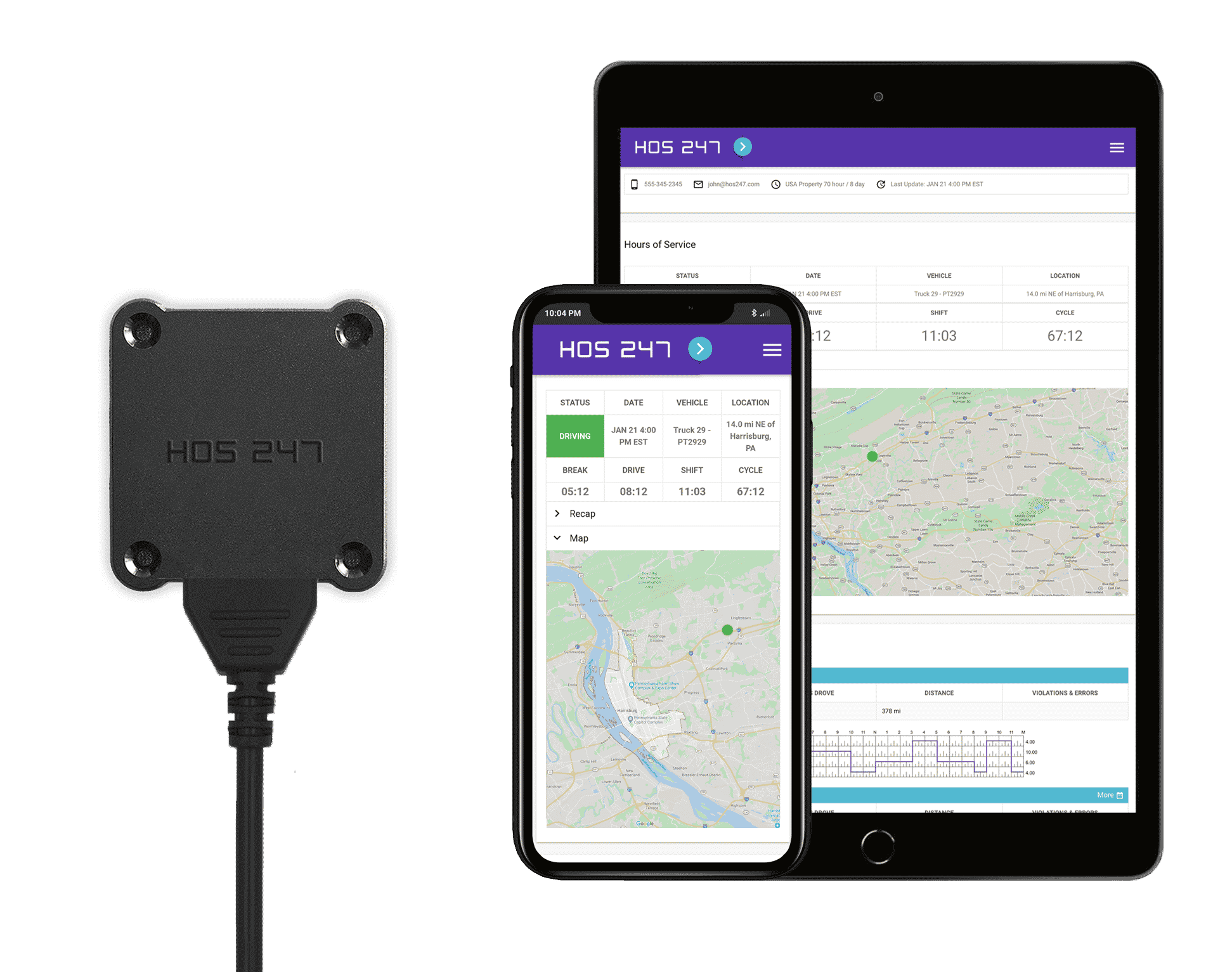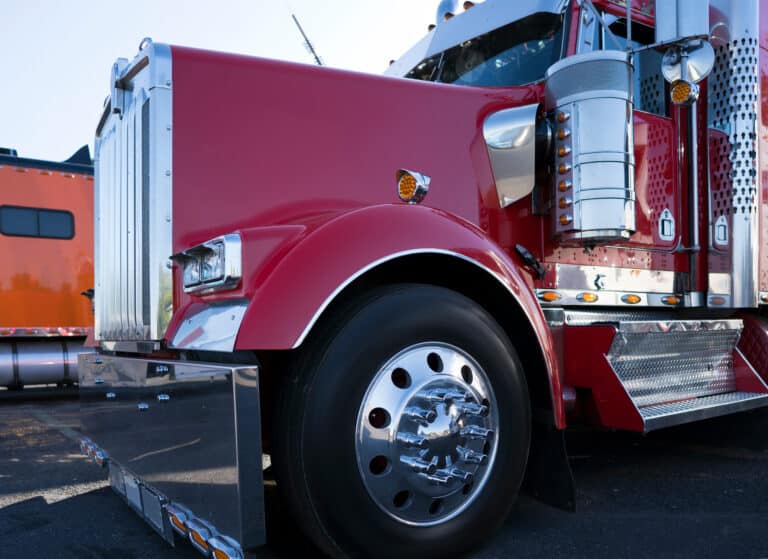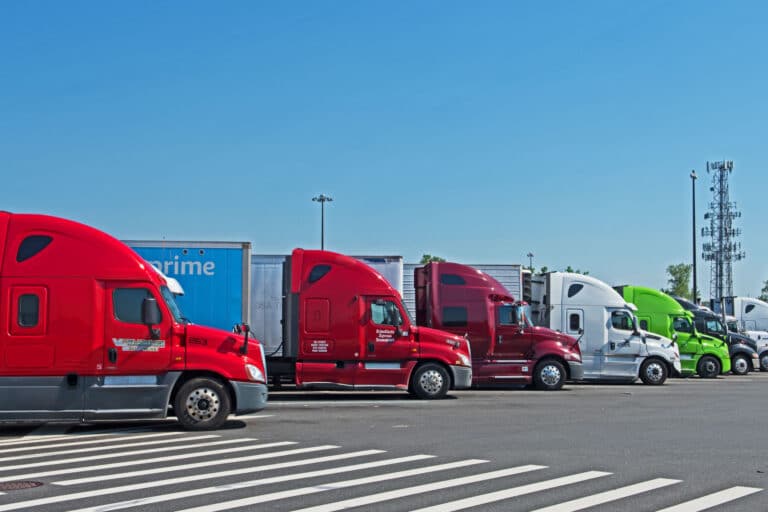Commercial drivers are legally required to use electronic logging devices and apps to record their hours of service (HOS). With over 800 systems available, choosing an electronic logbook can be a daunting process. While compliance is crucial, there are several other factors to consider when selecting the right hours of service ELD app.
Carriers should research and compare alternatives before committing to an ELD logbook app to find the best option for their business needs. For instance, if drivers find the ELD phone app difficult to use, they may not use it properly, putting your trucking operation at risk of noncompliance. This article aims to help truckers make the right choice for their operations. We will also cover HOS rules, their enforcement, and the impact of ELDs on fleet management.
Do you have any questions? Talk to ELD Advisor: 650-405-3372 or Request Callback
HOS247 Offers a Top-Rated ELD App
HOS247 ratings on Android and iOS app stores illustrate the quality of our top-rated electronic logbook. According to reviews on online platforms, ease of use, dependability, and superior customer support are some of the most appreciated benefits of using the HOS247 ELD app.
HOS247 has prioritized providing clients with an hours of service ELD app designed for reliable performance and compliance. Here are some advantages of HOS247:
- Top-rated customer support. Our team of experts is ready to assist you every day of the week in English, Spanish, Russian, and Polish. They are highly trained to resolve any issues as promptly as possible and will always call you back should the call drop.
- User friendly software. The driver app and the fleet manager portal were designed to simplify compliance. The system also provides valuable information to drive informed decision making and improve operations.
- Durable hardware. Our devices are sturdy to withstand the requirements of truckers and the installation of the HOS247 hardware is fast and straightforward. You can have your elog in place and get things up and running in just a few minutes.
- Flexible options. HOS247 plans can be scaled up or down as the customer needs. Also, HOS247 requires no long-term commitment on behalf of customers, so you do not need to sign a forceful contract.
- Trial period. We also offer a two week tryout period so that the users can get familiar with the product. If you wish to return the equipment after this time, you will receive a full refund.
- Extra features. GPS tracking, IFTA mileage calculations, preventative maintenance, idle monitoring, and vehicle diagnostics are available with the electronic logbook.
Are Elog Apps FMCSA-Compliant?
The Federal Motor Carrier Safety Administration (FMCSA) states that an electronic logbook is a device physically connected to the vehicle’s engine. Once connected, it should record HOS information and records of duty status. The device records the information, while the ELD logbook app serves as a tool for drivers, fleet managers, and roadside inspectors to access the gathered information.
Since the hours of service ELD app is simply installed on the driver’s phone or tablet, it is not not FMCSA-compliant by itself. However, it becomes compliant when synced with the elog system and paired with the hardware of a registered elogbook.

Choosing the Right ELD App for Your Trucking Operation
When selecting an ELD solution, the quality of the accompanying drive ELD app is crucial. A well-designed app can significantly improve driver experience and compliance. Here are key factors to consider:
- User interface. The app should be intuitive and easy to navigate, even for drivers who aren’t tech-savvy.
- Reliability. Look for apps with high uptime rates and positive user reviews regarding stability.
- Feature set. Beyond basic HOS logging, consider apps that offer additional features to fit your fleet’s needs.
- Offline functionality. The drive ELD app should be able to function and store data even when internet connectivity is lost.
- Regular updates. Choose a provider that frequently updates their app to address bugs and adapt to regulatory changes.
- Cross-platform compatibility. Ensure the app works well on both iOS and Android devices to accommodate all drivers’ preferences.
- Training resources. Look for providers that offer comprehensive training materials or videos to help drivers master the app quickly.
By carefully evaluating these factors, you can select an ELD solution with an app that enhances your operations.
Should Truckers Choose Android or iOS Apps to Run ELD Software?
Whether CMV drivers should choose an Android or iOS ELD app is a common question. However, it’s important to note that the online logbook app itself doesn’t have to be compliant. It’s the actual elog solution that drivers should be more concerned with. If the device connected to the vehicle isn’t compliant, neither the Android nor iOS app displaying its data will be useful.
Overall, whether Android or iOS is “better” depends on driver preference. That’s why HOS247 offers both Android and iOS apps, demonstrating our commitment to driver satisfaction. There’s no reason a driver should have to purchase a new smartphone or tablet and learn a new operating system if their current device works fine.
Any reputable electronic logbook provider should offer apps for both operating systems with driver convenience in mind.
About HOS Rules
Drivers who are subject to HOS regulations are required to limit the amount of time they spend driving or on duty. According to the FMCSA, the HOS rules apply to most CMV operators involved in interstate commerce and driving a vehicle that fits any of the following descriptions:
- Has a gross vehicle weight rating (GVWR) or a gross combination weight rating (GCWR) of 10,001 pounds or more.
- Is used to transport 16 or more passengers (including the driver) without driver compensation.
- Is used to transport nine or more passengers (including the driver) with driver compensation.
- Is transporting hazardous materials in a quantity that requires the use of placards.
Even if a driver is not required by law to follow the HOS rules, they should still consider using them as a guide to keep themselves and other drivers safe on the road. Using a registered ELD can help significantly while also boosting productivity.
Why Are HOS Rules Enforced?
Driver fatigue has been a significant problem since highways were created and commerce relied on drivers to transport goods across the country. When drivers spent hours behind the wheel without breaks, it led to fatigue, which caused a high number of accidents. The federal government is obliged to keep roads safe for travel, and HOS rules are part of its efforts to achieve this goal.
Commercial truck drivers have been maintaining Records of Duty Status (RODS) as part of HOS requirements since 1937. The rules have been revised throughout the years to keep up with new technology and to better address driver safety.
Who Enforces HOS Rules?
While the FMCSA creates HOS rules, it is the states’ departments of transportation that enforce them. This is typically done at weigh stations and when drivers are pulled over for inspections. The FMCSA also conducts a Compliance, Safety and Accountability (CSA) program used to monitor CMV operators’ compliance with highway safety regulations. If a driver has any HOS violations, it negatively affects their CSA score.
HOS violations are considered a serious danger to public safety by the FMCSA. As such, the agency may enforce corrective measures and even penalize the driver and their carrier. Such corrective measures can include a written warning, an official investigation, a fine, or even loss of their commercial driving certification.

ELD Logbook Apps Must Support the Updated Version of the HOS Rules
Elog providers need to constantly stay informed about changing regulations. If a device purchased five years ago hasn’t been updated, drivers could very well be facing noncompliance and being put out of service.
HOS247 has been providing reliable electronic logging devices and an online logbook app since before the elog mandate was officially passed. We have also kept up with changing regulations so drivers and fleet managers aren’t caught off guard. Part of that has been ensuring HOS247 Android and iOS apps support the most recent version of the HOS rules.
Before defining the most current HOS rules, it’s important to understand what “hours of service” means to the FMCSA. In short, HOS rules specify the maximum amount of time drivers are permitted to be on duty. Ultimately, these rules are intended to increase driver safety by ensuring they take sufficient rest periods, which in turn helps them stay more alert when driving.
The FMCSA published updated HOS rules on June 1, 2020, revising four provisions of the HOS regulations. The goal was to provide more flexibility for drivers without sacrificing safety. Motor carriers and CMV drivers were required to start complying with the current HOS rule starting September 29, 2020.
The four provisions that changed include:
- The short-haul exception. The new HOS rules expand the short-haul exception to a distance of 150 air miles and shifts of 14 consecutive hours, up from 100 air miles and 12 consecutive hours.
- Adverse driving conditions exception. Drivers can now extend both their on-duty and driving limits by two hours when encountering unexpected delays due to traffic or adverse weather.
- 30-minute break requirement. Drivers can now take their break within their first eight hours of driving time, rather than on-duty time. They can also allow a 30-minute period of on-duty time to qualify as the break, provided they weren’t driving during that time.
- Sleeper berth provision. Drivers can now meet their 10-hour off-duty requirement by spending at least seven hours of that period in the berth, with a minimum off-duty period of at least two hours spent inside or outside the berth. As long as they total 10 hours, neither period counts against their 14-hour driving window.
The Impact of ELDs on Fleet Management
The adoption of ELDs has revolutionized fleet management in several ways:
- Improved compliance. ELDs have significantly reduced HOS violations, leading to better CSA scores for carriers.
- Enhanced productivity. Automated logging saves drivers time, allowing them to focus more on driving and less on paperwork.
- Real-time visibility. Fleet managers can access up-to-date information on driver status and vehicle location, enabling better decision-making.
- Reduced operational costs. ELDs can help identify inefficiencies and fuel usage, leading to cost savings.
- Improved driver safety. By ensuring compliance with HOS rules, ELDs help combat driver fatigue and reduce accident risks.
- Easier audits. Electronic records simplify the process of DOT audits, saving time and resources for carriers.
- Data-driven insights. The wealth of data collected by ELDs can be analyzed to optimize operations and improve overall fleet performance.
As the industry continues to evolve, the role of ELDs in fleet management is likely to expand, offering even more benefits to carriers who leverage this technology effectively.
The Importance of Technology in HOS Compliance
As technology continues to advance, complying with HOS regulations and the elog mandate becomes increasingly straightforward. Given the accessibility and benefits of modern ELD solutions, using apps for accurate HOS recordkeeping is highly recommended. Implementing a top-rated hours of service ELD app promotes compliance, enhances safety, boosts productivity, and contributes to more profitable trucking operations.
Do you have any questions? Talk to ELD Advisor: 650-405-3372 or Request Callback
Common Challenges in ELD Implementation and How to Overcome Them
While ELDs offer numerous benefits, their implementation can present challenges. Here are some common issues and strategies to address them:
- Driver resistance. Some drivers may be hesitant to use ELD technology. Overcome this by providing comprehensive training and emphasizing the benefits of elogs, such as reduced paperwork and fewer HOS violations.
- Technical issues. Like any technology, ELDs can experience glitches. Choose a provider with reliable customer support and have a clear protocol for drivers to follow in case of technical failures.
- Data management. The influx of data from ELDs can be overwhelming. Invest in good data analysis tools and train your staff to interpret and act on the insights gained.
- Integration with existing systems. ELDs may need to work alongside other fleet management software. Ensure compatibility before purchasing, or consider a comprehensive solution that includes all necessary features.
- Compliance complexity. HOS rules can be complex, and ELDs must accurately reflect all exceptions and special cases. Choose an ELD provider that regularly updates their systems to reflect the latest regulations.
- Cost concerns. While ELDs represent an investment, focus on the long-term savings in terms of improved efficiency and reduced violations. Many providers offer flexible pricing models to suit different fleet sizes and budgets.
By anticipating these challenges and planning accordingly, fleets can smooth the transition to ELDs and maximize the benefits of this technology.

Installing Your HOS247 ELD: A Simple, Three-Step Process
Implementing an ELD should be straightforward and efficient. HOS247 offers a user-friendly installation process that can be completed in just three steps. Here’s how to get your HOS247 ELD up and running:
Step 1: Set Up the Web Portal
- Access the HOS247 portal at portal.hos247.com using your provided credentials.
- Navigate to the “Manage” section to input or update company details, vehicle information, portal users, and driver data. Note: Ensure unique login credentials for portal users and drivers, even if they’re the same individual.
Step 2: Install the ELD Hardware
- Connect the nine-pin ELD to the vehicle’s diagnostic port before starting the engine or launching the HOS247 app. Use adapters if necessary.
- Wait for the LED to flash green slowly, indicating power. A flashing red LED shows GPS acquisition; solid red means signal lock.
- Start the vehicle engine.
- Look for a rapid LED flash, signaling detected vehicle activity.
- Once the LED turns solid green, you’re ready to use the HOS247 app.
Step 3: Set Up the HOS247 ELD App
- Download the HOS247 ELD Logbook app from your device’s app store.
- Ensure Bluetooth is enabled on your device. (No manual pairing required)
- Log in using your web portal credentials.
- Choose a vehicle from your portal-created list.
- Enter the ELD’s MAC address (found on the device).
- Confirm the Bluetooth indicator appears in the app’s top right corner.
By following these steps, you’ll have your HOS247 ELD system operational quickly and efficiently. This streamlined process exemplifies HOS247’s commitment to user-friendly solutions that enhance compliance and productivity in your fleet operations.

Conclusion
Selecting the right ELD app is crucial for both compliance and operational efficiency. As we’ve explored, solutions like HOS247 offer user-friendly interfaces, reliable performance, and excellent customer support — key factors in choosing an ELD system. By understanding HOS rules, leveraging modern technology, and addressing implementation challenges, fleet managers can not only meet regulatory requirements but also optimize their operations.
The right ELD solution does more than just track hours of service; it enhances safety, improves productivity, and contributes to a more profitable business. As technology continues to advance, staying informed and adaptable will be key to success in the commercial trucking sector. Ultimately, investing in a quality ELD app is an investment in your fleet’s future, ensuring you remain compliant, competitive, and efficient in an increasingly digital landscape.

I’ve co-founded, built and managed several transportation-related businesses. Now, I’m a founder and CEO of HOS247 – an AI Transportation Platform for trucking companies, freight brokers and other logistics operations. We are transitioning old-style operations to technology-advanced logistics entities and help them to grow their businesses. ELDs (electronic logging devices), fleet tracking and management 2.0 combined with AI-powered dispatch tools.












The ELD electronic logging device has become an essential tool for trucking professionals since the FMCSA issued its mandate. This legislation is aimed at commercial vehicle drivers who are required to keep RODS and operate under HOS rules. In this

Commercial driver log book regulations established by the FMCSA in 2017 have significantly changed how truckers deal with HOS rules. Paper logs were replaced by electronic logging devices to record driving activity more accurately by synchronizing directly with the vehicle’s

Optimizing Operations with Mobile Device Fleet Management Solutions Effective fleet management is crucial for ensuring operational efficiency, cost control, and customer satisfaction in the transportation sector. The widespread adoption of mobile devices and advancements in technology have revolutionized fleet operations